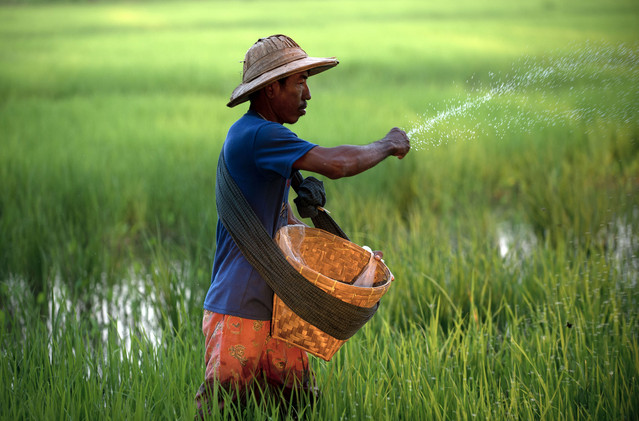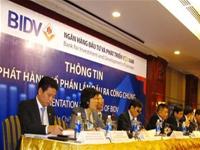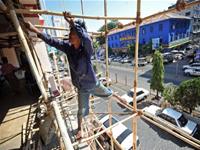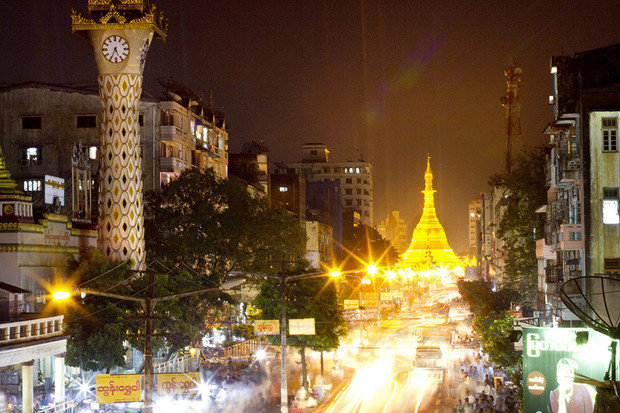Myanmar seeks to regain top spot in rice exports: Southeast Asia
Myanmar seeks to regain top spot in rice exports: Southeast Asia
Myanmar, the world’s top rice shipper before five decades of military dictatorship made it Southeast Asia’s poorest nation, plans to double exports over five years, threatening to aggravate a global glut.

Rice from Myanmar is about $10-$20 per ton cheaper than the comparable quality from Vietnam, India and Pakistan, said Jac Luyendijk, chief executive officer at SAT Swiss Agri Trading AG, which handles about $300 million worth of rice a year
|
Overseas sales may climb to as much as 3 million metric tons by 2017 from 1.5 million tons in the year ending March 2013 as yields and infrastructure improve, Ye Min Aung, secretary- general of the Myanmar Rice Federation, said on Oct. 25. The U.S. Department of Agriculture raised its export forecast for Myanmar by 25 percent to 750,000 tons for this year on Oct. 11.
The country that could be Asia’s next economic frontier, according to the International Monetary Fund, is reviving the rice trade as it reengages with the global economy and shifts back toward democracy. The 2017 target would be equivalent to 8 percent of world exports this year, which are forecast by the USDA at 37.7 million tons. The global market in rice, a staple for half the world, has been in a surplus for seven years.
“The international rice market is very crowded with new exporters like Brazil, Russia and Egypt,” Concepcion Calpe, a senior economist at the United Nations’ Food & Agriculture Organization, said from Rome. “Unless there is a disaster of some sort, we still see the world rice economy facing an ample supply situation in 2012 and 2013.”
The country plans to more than double yields to as much as 4 tons per acre in five years from about 1.25 tons to 1.5 tons currently, said Ye Min Aung of the federation, which accounts for more than 80 percent of the nation’s output. “We are looking to boost productivity as well as income for farmers.”
Biggest shipper
Myanmar was the world’s biggest exporter from 1960 to 1963, with shipments of 1.6 million to 1.7 million tons a year, until it was displaced by neighbor Thailand, according to USDA data. Last year, it shipped 778,000 tons, ranking ninth after Uruguay, and exports reached a nadir of 15,000 tons in 1996-1997. This year, global rice output will exceed demand by 9.7 million tons, up from 5.6 million tons the previous year, USDA data show.
It may take 10 years to 15 years for Myanmar to become a top shipper again, shorter than the two decades Vietnam took to become a top-three exporter, said Robert Zeigler, secretary- general of the International Rice Research Institute in the Philippines. “We see Myanmar as an extremely important source for rice production - there’s no question about it,” he said.
Myanmar’s strengths are low production costs, vast land and abundant water and labor, according to the Asian Development Bank, which says the country needs to increase farm output to spur per-capita gross domestic product almost fourfold by 2030. At present, agriculture accounts for 36 percent of an economy that expanded 5.5 percent last year, and employs most of the country’s 64 million people.
Cheaper supplies
“The country has yet to have a proper legal, regulatory and institutional setup,” said Cyn-Young Park, assistant chief economist at the ADB. “So the talks on investments, though a lot has been said, haven’t actually been materialized.”
Rice from Myanmar is about $10-$20 per ton cheaper than the comparable quality from Vietnam, India and Pakistan, said Jac Luyendijk, chief executive officer at SAT Swiss Agri Trading AG, which handles about $300 million worth of rice a year. Constraints include antiquated ports, which may not be able to handle a sudden gain in volume especially during the rainy season, he said.
The Port of Yangon handles about 90 percent of the nation’s trade, according to the Ministry of Transport. Japan wants to build a port and industrial estate at Thilawa, 25 kilometers (16 miles) south of Yangon. Italian-Thai Development Pcl, Thailand’s biggest contractor, is also trying to get Japan to finance an $8.6 billion deep-sea port and industrial zone in Dawei.
Rice rally
Other nations are boosting their rice sales to tap the market where prices have more than tripled in the past decade. Rough-rice trades at $15.135 per 100 pounds ($330 a metric ton) in Chicago now, up from $3.91 at end-2001. Brazil exported 1.3 million tons last year, tripling from the year before, and will sell 1.1 million this year, according to the USDA.
Larger supplies from Myanmar won’t necessarily hurt international prices, said Calpe from the Rome-based FAO. “Rice is a dynamic market subject to many interventions by governments,” including Thailand, she said.
Thailand’s exports may fall 39 percent to 6.5 million tons this year from 10.6 million tons in 2011, according to the USDA, as Prime MinisterYingluck Shinawatra has pledged to guarantee minimum prices for farmers, boosting stockpiles to the highest ever. That means Thailand would slip behind India and Vietnam.
Hybrid seeds
The Myanmar government will soon allow seed imports and introduce hybrid seeds to increase harvests, according to Maung Aung, an agriculture policy adviser at the Ministry of Commerce.
“Agricultural development is the first priority for the government,” he said by phone from Naypyidaw, the capital. “Since production of agricultural products such as rice is low, the government is pushing to increase both quality and quantity in the agricultural sector.”
China’s increasing demand for the grain may help mop up rising supplies from Myanmar, as imports soared to 1.9 million tons this year from 575,000 tons in 2011, vying with Iran as the largest buyer of the grain after Nigeria, the USDA says.
“China may become the largest importer by 2015,” said Myo Thuya Aye, a senior central executive member of the rice federation whose family has been trading rice since 1952.
President Thein Sein, who took power last year in elections that ended about five decades of military rule, targets annual GDP growth of 7.7 percent over the next five years. His government plans to expand credit, increase fertilizer use and promote higher-yielding rice strains to boost farmers’ incomes and cut the poverty rate to 16 percent by 2015 from 26 percent.
‘Economic frontier’
At present, Myanmar has the smallest GDP on a per-capita basis in the Association of Southeast Asian Nations, UN data show. Still, the country “could become the next economic frontier in Asia” if it takes advantage of rich natural resources, young labor force and proximity to China and India, IMF mission head Meral Karasulu said in January.
Myanmar’s renewable water resources are among the highest in Asia at 24,352 cubic meters per inhabitant per year, the ADB said in August. It currently uses about 5 percent of its water resources, giving it “substantial” potential for increased irrigation, hydropower and livestock production, the ADB said.
“Myanmar has a great potential no doubt,” ADB’s Park said. “But it’s a country in transition, so that’s the caveat.”
bloomberg

















